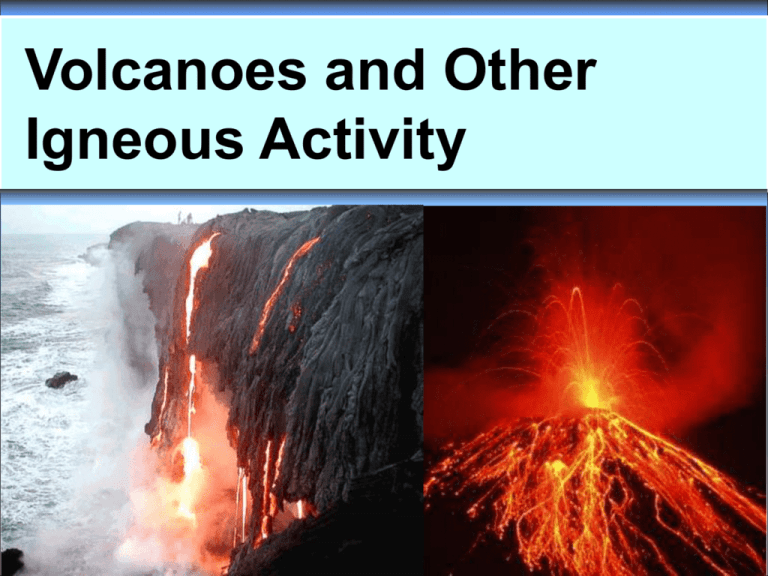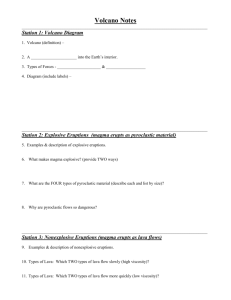10.1 The Nature of Volcanic Eruptions
advertisement

Volcanoes and Other Igneous Activity Volcano Defined • A volcano is an opening in a planet's crust, which allows hot magma, ash, rock and gases to escape from below the surface. Volcano Word Origin • The word volcano is derived from the name of Vulcano island off Sicily which in turn, was named after Vulcan, the Roman god of FIRE. Introduction to Volcanoes + Top Five Volcano Webcams Volcano Origins Volcanoes are found on top of magma chambers and have large central vents through which the tephra and gases erupt. At the top of the central vent is a crater. Tephra, from the Greek meaning ash, are rock fragments and particles ejected by the volcanic eruption. Tephra = Pyroclastic materials 10.1 The Nature of Volcanic Eruptions Factors Affecting Eruptions Factors that determine the violence of an eruption • Composition of the magma • Temperature of the magma • Dissolved gases in the magma Viscosity • Viscosity is the measure of a material's resistance to flow. 10.1 What is viscosity? What is more viscous? Viscosity: The state of being thick, sticky, and semifluid in consistency. Increasing Viscosity: Water Orange Juice Canola Oil Maple Syrup Motor Oil Jams Peanut butter Grease Cement Glass Viscosity of two liquids 10.1 The Nature of Volcanic Eruptions Factors Affecting Eruptions Viscosity • Factors affecting viscosity - Temperature (hotter magmas are less viscous) - Composition (silica content) 1. High silica—high viscosity (e.g., rhyolitic lava stream stone) 2. Low silica—more fluid (e.g., basaltic lava) Magma Composition Magma Composition (Raise the BAR) Magma Definitions: Basaltic: (Touchstone) Fine-grained black volcanic rock. Andesitic: (Andes Mountains) Finegrained brownish-gray volcanic rock of intermediate composition between basaltic and rhyolitic. Rhyolitic: (Lava-stream stone) Finegrained pale volcanic rock of granite composition. 10.1The Nature of Volcanic Eruptions Volcanic Material Lava Flows • Basaltic lavas are more fluid because lower silicates. • Types of lava - Pahoehoe lava (resembles braids in ropes) - Aa lava (rough, jagged blocks) Gases • One to 5 percent of magma by weight • Mainly water vapor and carbon dioxide Silica Levels • The magma that flows from volcanoes contains rock/minerals including silica. • If the magma is high in silica, the higher the viscosity and the less the lava flows. • The lower the silica level, the lower the viscosity and the more easily the lava flows. Magma Flow Conclusions: • Sooooooo… Silicates slow lava flow High Silicates = High Viscosity Low Silicates = Low Viscosity Pahoehoe (Ropy) Lava Flow Pahoehoe lava flow video Slow-Moving A’a Flow A'a Lava flow Which are they? 10.1 The Nature of Volcanic Eruptions Factors Affecting Eruptions Dissolved gases • Mainly water vapor (H2O) and carbon dioxide (CO2), but also include, sulfur dioxide (SO2), hydrogen chloride (HCl), hydrogen fluoride (HF) • Gases expand near the surface • A vent is an opening in the surface of Earth through which molten rock and gases are released. • Provide the force to extrude lava 10.1 The Nature of Volcanic Eruptions Factors Affecting Eruptions Dissolved gases Many different gases can be ejected from a volcano into the atmosphere. The gases provide the force to eject the tephra from the central vent. Dissolved Gases • The more viscous (thicker) the magma, the slower the gases can rise through the central vent and, therefore, the more pressure that builds and the more explosive the eruption. Dissolved Gases Sooooo……. Thicker lava (more viscous) = more pressure building up = more explosive eruption 10.1 The Nature of Volcanic Eruptions Volcanic Material Pyroclastic Materials • Pyroclastic materials is the name given to particles produced in volcanic eruptions. • The fragments ejected during eruptions range in size from very fine duct and volcanic ash (less than 2 millimeters) to pieces that weigh several tons. • Sizes from 2 mm to 2 tons! Tephra = Pyroclastic materials 10.1 The Nature of Volcanic Eruptions Volcanic Material Pyroclastic Materials (Lava Solids!) (pyro (fire) + clast (broken in pieces) • Types of pyroclastic material - Ash and dust—fine, glassy fragments - Pumice—frothy, air-filled lava - Lapilli—walnut-sized particles - Cinders—pea-sized particles • Particles larger than lapilli - Blocks—hardened lava - Bombs—ejected as hot lava 10.1 The Nature of Volcanic Eruptions Volcanic Material Pyroclastic Clouds (Flows) • These fast moving clouds of hot gas and rock are the Real Killers! - Normally hug the ground and flow downhill - Up to 700 km/hr (450 mph), cannot outrun them. - People cooked in the 1000 °C (1,800 °F) heat. - Body instantly reduced to charcoal. Pyroclastic Clouds: The Real Killers Pyroclastic Flows 10.1 The Nature of Volcanic Eruptions Types of Volcanoes The four main volcanic types are: 1) shield volcanoes, 2) cinder cones, 3) composite cones, and 4) lava domes. Anatomy of a Volcano • A volcano is a mountain formed of lava and/or pyroclastic material. • A crater is the depression at the summit of a volcano or that which is produced by a meteorite impact. • A conduit, or pipe, carries gas-rich magma to the surface. Anatomy of a “Typical” Volcano Types of Volcanoes There are three major types of volcanoes (and one minor): • Shield volcanoes • Cinder cones • Composite/Stratovolcano • Lava domes (minor) 10.1 The Nature of Volcanic Eruptions Types of Volcanoes Shield Volcanoes (made by lava liquid) • Shield volcanoes are broad, gently sloping volcanoes built from fluid basaltic lavas. • Liquid, fluid lava flows versus pyrocastic solid lava. Shield Volcanoes (from liquid) • Shield volcanoes have shallow-sloping sides (looking like a shield from the side or from the air). • These volcanoes form from fluid lava that can travel for long, long distances before hardening. This leaves a large volcano with a small slope. Shield Volcanoes Hawaii Big Island: Shield flow volcano Examples of Shield Volcanoes • Kilauea • Lo`ihi • Mauna Loa • Hualalai • Mauna Kea • Kohala 10.1 The Nature of Volcanic Eruptions Types of Volcanoes Cinder Cones (made by lava solids) • Cinder cones are small volcanoes built primarily of pyroclastic material ejected from a single vent and then cool quickly in the air. These accumulate to make the sides of the volcano. - Steep slope angle - Rather small in height and size - Frequently occur in groups The cinders up-close! Cinder Cones Cinder Cone: Pericutin, MX Paricutin, MX: Cinder Cone Volcano Cinder Cone: Sunset Crater,AZ 10.1 The Nature of Volcanic Eruptions Types of Volcanoes Composite Cones (a.k.a. stratovolcanoes) • Composite cones are volcanoes composed of both lava flows and pyroclastic material. - Most are adjacent to the Pacific Ocean (e.g., Mt. Rainier). - Large size and high in height - Interbedded lavas and pyroclastics - Most violent type of activity Mount Vesubius/Pompeii: Composite Cone Composite/stratovolcanoes • Stratovolcanoes are tall and steep. They have periodic, explosive eruptions. • These volcanoes are tall and steep because they erupt viscous (thick) lava that cools and hardens before is spreads very far. Composite/stratovolcanoes • Composite means BOTH…both what? • Made by BOTH lava solids (pyroclastic materials) and by lava liquid (lava flows). Composite Cones Stratovolcanoes Mammoth Mountain, CA (dormant) Mt. Fuji, Japan Mt. Pinatubo, Phillipines Mt. Etna, Sicily Mt. Shasta, CA (dormant) Mt. Unzen, Japan Mt. Rainier, WA Mt. St. Helens, WA Krakatoa, Indonesia Mt. Vesuvius, Italy Mount St. Helens Before and After the May 18, 1980, Eruption Before After Krakatoa (1883) decreased global temperatures by 4⁰ F for 5 years Lava Domes • Lava domes are a type of volcano that are formed by lava that is too viscous to flow any great distance. • The thick lava extrudes from the central vent, cools down and hardens around the vent. Lava domes can occur by themselves or on the flanks of large composite volcanoes. Lava Domes Lava Domes at Mount St. Helens Lava Domes • Lava domes are often very, very dangerous. Thinking about the viscosity of the lava, why do you think they are dangerous? Lava Domes Lava Dome Profiles of Volcanic Landforms 10.1 The Nature of Volcanic Eruptions Other Volcanic Landforms Calderas • Calderas are large depressions in volcanoes. • Nearly circular • Formed by collapse • Size exceeds one kilometer in diameter 10.1 The Nature of Volcanic Eruptions Other Volcanic Landforms Volcanic Neck • A volcanic neck is a cylindrical-shaped landform standing above the surface created by magma solidifying in the vent of a volcano. Erosion of the sides of the volcano exposes the neck. 10.1 The Nature of Volcanic Eruptions A Volcanic Neck: Devil’s Tower, WY 10.1 The Nature of Volcanic Eruptions Build Your Own Volcano! Click here to: Build Your Own Volcano! 10.1 The Nature of Volcanic Eruptions Other Volcanic Landforms Lava Plateaus • Wide areas formed when fluid basaltic lava extrudes from crustal fractures called fissures. Complete Study Guide 10.1 Supervolcanoes! • A supervolcano is a volcano that produces an eruption that ejects more than 1,000 km3 of tephra (240 mi3). • This amount of ejecta is thousands of times larger than most historic volcanic eruptions. • Supervolcanoes usually occur when magma in the Earth rises into the crust from a hotspot but is unable to break through the crust. Pressure builds in a large and growing magma pool until the crust is unable to contain the pressure…. …. and BAM!!!!!!!!!!!!!!!!!!!!!!!!! The world is changed! Six, Pretty-Famous Supervolcanoes! 1) 2) 3) 4) Yellowstone, WY Long Valley, CA (Mammoth Mt.) Valles Caldera, NM. Lake Toba, Indonesia (Largest eruption in the past 25 million years! It erupted 74,000 years ago.) 5) Taupo Volcano, New Zealand; 6) Aira Caldera, Japan. Cross-Section through Mammoth Supervolcano Hotspot Locations for Yellowstone Supervolcano (million of years ago) • An eruption of a supervolcano can cause a global climatic change (typically a mini-Ice Age, “volcanic winter”) and major species extinctions!






